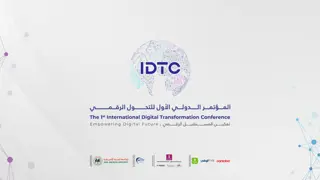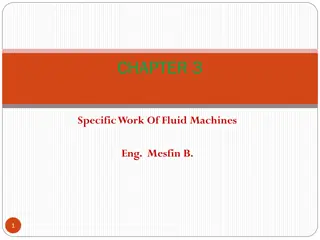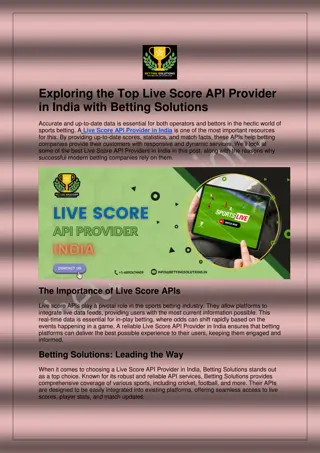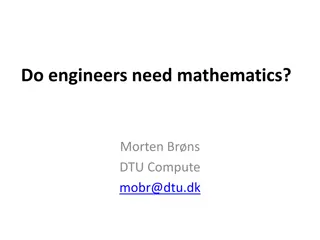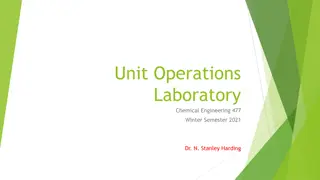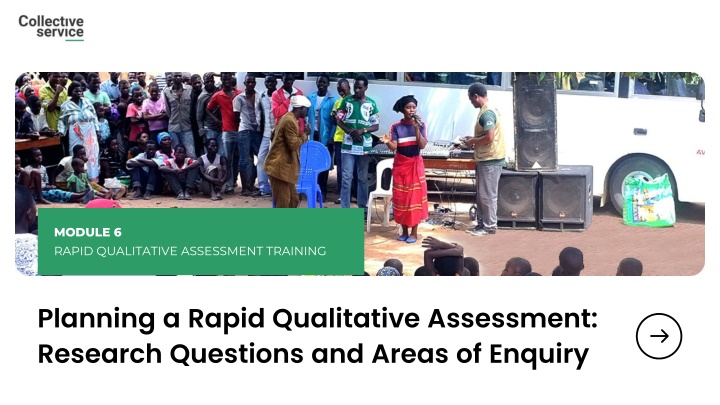
Planning a Rapid Qualitative Assessment: Research Questions and Areas of Enquiry
Learn the process for designing and conducting a Rapid Qualitative Assessment (RQA), including developing research questions, identifying existing data, and communicating findings. Explore the importance of evidence in enhancing skills-building for a competent RCCE workforce. Understand key considerations before starting the assessment, such as the need for an RQA, social dynamics, and relevant sources of evidence.
Uploaded on | 0 Views
Download Presentation

Please find below an Image/Link to download the presentation.
The content on the website is provided AS IS for your information and personal use only. It may not be sold, licensed, or shared on other websites without obtaining consent from the author. If you encounter any issues during the download, it is possible that the publisher has removed the file from their server.
You are allowed to download the files provided on this website for personal or commercial use, subject to the condition that they are used lawfully. All files are the property of their respective owners.
The content on the website is provided AS IS for your information and personal use only. It may not be sold, licensed, or shared on other websites without obtaining consent from the author.
E N D
Presentation Transcript
MODULE 6 RAPID QUALITATIVE ASSESSMENT TRAINING Planning a Rapid Qualitative Assessment: Research Questions and Areas of Enquiry
Process for designing and conducting an RQA Ethical principles for conducting RQAs Establish why an RQA is needed 01 05 Develop the tool and do the assessment Identify existing data 02 06 Develop research questions Communicate the findings 03 07 Ensure findings are used to inform action Set out Terms of Reference 04 08
Newly published WHO RCCE competency framework to guide skills-building for a competent RCCE workforce. Why is evidence needed? Includes behaviours, activities and tasks for evidence-based RCCE. Rapid assessments is one approach to enhance evidence-based RCCE
Competency 13. Assesses and uses relevant evidence 13.1 Participates in seeking evidence from social and behavioural sciences ro inform RCCE activity. 13.2 Uses a structured and replicable approach to gather evidence to deliver key RCCE tasks. 13.3 Uses evidence for specific purposes and can describe that purpose. 13.4 Critically ealuates the limitations, quality, relevance and application of evidence. 13.5 Communicates structured, comprehensible and accurate evidence and analytics with appropriate audiences to update and enhance RCCE practice.
Before you start the process, remember to establish: Key Reasons Why is an RQA needed 01 02 03 04 Understand key social, cultural, political, and economic dynamics Identify relevant authorities and trusted leaders for message dissemination; Gather communities understanding of the disease and health decision-making processes; Inform appropriate and effective response efforts.
What existing evidence can you refer to? RQAs are needed when existing information is insufficient or out of date to address your questions Possible Sources Compiling existing evidence National RCCE plan Health partners / NGOs data Internet searches Context / situational analyses Socio-behavioural studies Community mapping Report from previous RQA Vulnerability mapping Communications analyses
Phase 1: What are your key questions? Our questions change during the process of research to reflect an increased understanding of the problem (Crestwell 2007) Develop an overarching question Driven by the HOW and the WHY of an issue or topic
Moving from Exploratory to Deep Dive RQA Our questions change during the process of research to reflect an increased understanding of the problem (Crestwell 2007) Phase 1: Exploratory Phase 2: Deep Dive How are communities affected by the current drought conditions in Zambia? How are communities and actors responding? Why?
Phase 2: what are your key questions? 01 04 Iterative process to develop specific sub-questions and areas of enquiry within your broader topic. Drivers of a behavior (why) 02 05 Engagement with other stakeholders (govt, aid/relief, community members) Particular vulnerable population groups 03 Processes (how)
Terms of Reference (ToR) 1 - Structure Background Budget 01 06 Objectives & questions of enquiry Team composition 02 07 Scope of work Ethical considerations 03 08 Deliverables Reporting 04 08 Timeline 05
Terms of Reference (ToR) 2 - Scope of work The Scope of Work covers the key activities: Stakeholder Engagement: Data Collection and methods: Boundaries Engage with key stakeholders from the RCCE pillar and other pillars RQA using the following methods e.g. Conduct FGDs with community members; IDIs with key informants such as healthcare providers, local leaders, and affected families. Observation, other participatory methods Who / what is included and excluded from the assessment, what locations will it take place in? Which methods in which locations. Data Analysis: Reporting: Method for rapid analysis of the data What format will the RQA outputs take? Who will the audiences be?
Terms of Reference (ToR) 3 - The Scope of Work covers the key activities: Timeline Budget Establish timeline, including any key milestones and deadlines Outline the budget and resources to ensure the project stays on schedule (remember the focus is on rapid) Team composition Ethical considerations Who will do the work? Outline responsibilities of the principle investigator, research assistants, analyst, community gatekeepers etc. Outline the ethical issues and measures to maintain ethical principles
Key Ethical Principles Ethical principle Application Respect for persons Informed consent Privacy and Confidentiality Individuals should be treated as independent individuals, not under the control of others People with diminished ability to act independently require special protection The person should have the capacity to give consent and should have the power of choice without constraint or coercion without feeling forced or persuaded The person should have sufficient knowledge and understanding to enable him or her to make the right decision If someone is under the legal age of adulthood, assent should be gained from them, and consent should be gained from a caregiver over the legal age of adulthood Respect confidentiality participants should be able to choose whether their statements are public and attributable (quoted on record ) or whether their statements are anonymous or not to be quoted ( off record ). Respect privacy participants should be able to speak in a comfortable setting free from onlookers; participants should never be forced to reveal information about themselves that the participant does not wish to reveal. Data should be anonymized (where the participant does not request attribution), identifiable information should be removed and data should not be able to be linked to any one person Data should be stored securely Right to withdraw This should be possible at any time during the assessment, without consequence This includes the right to ask for the tape-recorder (if one is used) to be switched off
Key Ethical Principles Ethical principle Application Do No Harm Assessment of risks and benefits No harm should be done to participants Beyond this, benefit should also be gained from participation in the assessment. Common questions we ask ourselves include: should this be a social or a personal benefit? Who should decide what the benefit should be? The assessment should be necessary and meaningful it should be unique and it should contribute to the greater good The nature of risks and benefits should be assessed in a step-by-step way. Risk can be defined as: the probability of harm or injury (physical, psychological, social or economic) occurring as a result of participation in research. The potential benefit of the work should outweigh the probability and severity of risks. More information can be found here. Justice Selection of participants Treat people equally, fairly and respect their rights The risks of research should be negligible In participant selection, wherever you can include a wide range of people; think about gender, ethnicity, and marginalized groups Think about specific groups who are particularly vulnerable to the impacts of the crisis you re supporting and make sure you include them
Challenges to Applying Ethical Principles Do No Harm When have you faced this? Informed consent When have you faced this? Confidentiality and privacy When have you faced this?
Ethics Approvals 01 03 Ethics review board approval process is not required for RQAs as data needs to be used in as close to real-time as possible Rapid Qualitative Assessments are intended for informing operational response decision making 02 04 BUT ethical principles must still be maintained Data is not intended to be published in academic publications
Ethics Approvals with Communities How might ethical principles be maintained with communities involved in RQAs?
Consider your current work with communities. Which ethical principles guide your work? Key Ethical Principles
Ethical Approvals and Consent 01 04 Acknowledge the leadership of the community Acknowledge the members of the community 02 05 06 Seek permission to conduct the rapid qualitative assessments Ask their permission to enter the community 03 Explain the rapid qualitative assessments that you are planning to carry out and the potential benefits and risks Consider who you obtain permission from - think about power dynamics in the community: who has the authority to give permission, who is excluded from such decision making? Does permission given from leadership extend to all members?
Ethical Approvals and Consent 07 08 Explain informed consent and data privacy Consider establishing formal mechanisms such as community advisory boards to work with throughout the phases of the RQAs: data collection, analysis of findings, development and implementation of recommendations 09 Ensure time and budget for discussing the findings with communities and supporting locally-led action
The ethical principles that guide operational social science assessments include respect for persons, doing no harm, and justice. Including: Getting voluntary informed consent from participants Allowing the right to withdraw at any time Maintaining privacy Summary Weighing risks and benefits of participating Selection of participants Formal ethical approval from an institutional ethics review board is not required for RQAs but ensuring ethical principles are respected is still critical Community leaders and members participating in RQAs should be involved at each stage of the process: data collection, analysis of findings, development and implementation of recommendations
Debrief and Reflections from Day 1 01 02 03 What did you learn yesterday? What was something new or interesting? What questions do you have?
Identification of Gaps 01 02 For Cholera or for Drought What do we need in order to act? What don t we know? In small groups, after we hear the Drought RQA findings, we will develop the priority gaps. Use resource people or key documents
Designing a topic guide
Methods for developing the tool (1) Resources for developing RQA Tools: 01 Identify key areas of inquiry, e.g.: Factors affecting healthcare seeking behavior Beliefs/perceptions/ practices around an outbreak or a disease Experiences with the disease, perceived social impacts Bank of Risk Communication and Community Engagement Assessments, Surveys, and Feedback Tools SSHAP Rapid Anthropological Assessments in the Field 02 Collective Service Cholera Questions Bank Identify existing tools/resources
What is your AOE? What is your target population? What are your key questions? Develop your data collection tool (guides) on the basis of your area of enquiry (AOE) and target population. 01 02 Key Informant Interview (KII) Guide Focus Group Discussion (FGD) Guide
What is your AOE? What is your target population? What are your key questions? Area of enquiry (AOE) ? Topic sentence ?
Methods for developing the tool Develop the data collection tool Whenever possible, keep questions open- ended (not yes/no not a survey) Identify and include probes and alternate wording for questions that may be challenging to interpret
Methods for developing the tool Develop the data collection tool (cont d) Start with sociodemographic questions (less emotionally charged, build rapport) Group questions by thematic area Order questions chronologically when possible Review and revise tools with team Pilot test and adapt as needed
Using findings Communication of findings should promote: Consider: inclusive health emergency management meaningful engagement community centred practice Who are your key audiences / stakeholders? What are their: Interests and priorities Opinions (Political) motivations and goals Blockages for action Language What format works best for your audience - use different formats for different audiences. Use different events and existing channels to have maximum impact
Communicate findings Key findings should be linked to concrete recommendations and to its potential impact Example recommendation: Example recommendation: RCCE actors should provide guidance on how people can access vaccinations. Communications should address concerns about vaccine safety and side effects. Emerging types of misinformation around vaccines should be tracked, and approaches developed to dispel hesitancy. These measures could help increase uptake of vaccination. It helps the intended users understand: This finding is crucial to the outcome of the vaccination programme There is something actionable we can do about this That action will have impact
Using findings Recommendations for impact Make the recommendations fit the context and resources available Separate short-term recommendations that are easily actionable from the recommendations that may take more time and resources to achieve Clearly target each recommendation to a specific user e.g. which recommendations are for fellow community engagement and/or communications actors, which are for government actors, which are for communities and so on Where ever possible, develop these recommendations jointly with affected communities, or get their input and feedback.

